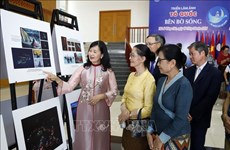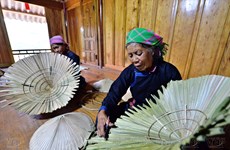Dak Lak hangs on to vanishing heritage
The Central Highlands province of Dak Lak is being stripped of its
cultural heritage as gongs, drums and many ancient hunting knives and
tools are used to feed the thriving trade in ethnic antiques, officials
warn.
The Central Highlands province of Dak Lak is being stripped of its
cultural heritage as gongs, drums and many ancient hunting knives and
tools are used to feed the thriving trade in ethnic antiques, officials
warn.
Buon Trap town in Krong Ana district boasts an all-woman team playing the Jo, a gong designed exclusively for women of the E De ethnic group.
"The team play on two ten-gong sets which are owned by a local family. Six gongs were sold to antique collectors in recent years and two others were broken," said Tran Viet Du, an official with the district's Culture Office said.
"When the team play the Jo, we have to rent gongs from a nearby town for the performers," Du said.
"Buon Trap is one of many locations in the province where gongs have been sold to traders that can never be replaced again," said Y Wai Bya, director of Dac Lac's Culture, Sports and Tourism Department.
"That is due largely to the poverty of the local people. Many people do not hesitate to sell antique gongs to collectors to get large sums of money," he said.
Du and Bya are among many officials who have expressed growing alarm about the antique trade in Central Highlands provinces.
"Researchers specialising in the Central Highlands' culture and history need to come up with long-term strategies for the preservation of gongs, drums and other old items relating to ethnic culture," Bya said.
Bya admitted that the province still lacked policies to preserve gongs and train officials to gain a profound understanding of traditional music and the culture of ethnic people.
Bya said the provincial People's Committee recently approved a policy to assist gong owners.
"Each family that owns an antique gong will receive an annual stipend of 500,000 VND (25 USD) from the province," he said, giving no further details.
The committee is also working on a project to build in each village a museum to display traditional musical instruments and items used in the daily lives of the ethnic people.
"More festivals will be organised in Dak Lak's villages and districts where ethnic people can perform gongs, drums and introduce their folk music to outside audiences," Bya said.
The centuries-old gong music is a precious cultural heritage of Vietnam's ethnic people. They play the gong to commemorate a good harvest, during festivals, and to mark occasions like the birth of children, weddings, and funerals.
The Central Highlands gong culture was recognised as a Masterpiece of Oral and Intangible Cultural Heritage by UNESCO in 2006.
Cultural researcher Y Duong, grandson of Y Jut Nie K'Dam, author of the first Vietnamese – E De Dictionary, said he had spent many years working on a project to protect gongs and would submit it soon to the Dak Lak People's Committee for consideration.
Apart from ancient gongs and drums, K'pan long benches used by gong performers and tools used by hunters of elephants and wild animals are much sought after by antique traders.
Ama Pet, a well-known elephant hunter in Buon Don town, said he was among few people who still kept the leather ropes used in elephant hunting.
Pet caught and domesticated 15 elephants using his rope which is more than 10m in length. Elephant hunting is now banned in Dak Lak. He said he intends to sell his rope to have money to spend for the family.
He said he has priced the rope at 15 million VND (750 USD) including a piece of buffalo leather used to cover the back of the elephant./.
Buon Trap town in Krong Ana district boasts an all-woman team playing the Jo, a gong designed exclusively for women of the E De ethnic group.
"The team play on two ten-gong sets which are owned by a local family. Six gongs were sold to antique collectors in recent years and two others were broken," said Tran Viet Du, an official with the district's Culture Office said.
"When the team play the Jo, we have to rent gongs from a nearby town for the performers," Du said.
"Buon Trap is one of many locations in the province where gongs have been sold to traders that can never be replaced again," said Y Wai Bya, director of Dac Lac's Culture, Sports and Tourism Department.
"That is due largely to the poverty of the local people. Many people do not hesitate to sell antique gongs to collectors to get large sums of money," he said.
Du and Bya are among many officials who have expressed growing alarm about the antique trade in Central Highlands provinces.
"Researchers specialising in the Central Highlands' culture and history need to come up with long-term strategies for the preservation of gongs, drums and other old items relating to ethnic culture," Bya said.
Bya admitted that the province still lacked policies to preserve gongs and train officials to gain a profound understanding of traditional music and the culture of ethnic people.
Bya said the provincial People's Committee recently approved a policy to assist gong owners.
"Each family that owns an antique gong will receive an annual stipend of 500,000 VND (25 USD) from the province," he said, giving no further details.
The committee is also working on a project to build in each village a museum to display traditional musical instruments and items used in the daily lives of the ethnic people.
"More festivals will be organised in Dak Lak's villages and districts where ethnic people can perform gongs, drums and introduce their folk music to outside audiences," Bya said.
The centuries-old gong music is a precious cultural heritage of Vietnam's ethnic people. They play the gong to commemorate a good harvest, during festivals, and to mark occasions like the birth of children, weddings, and funerals.
The Central Highlands gong culture was recognised as a Masterpiece of Oral and Intangible Cultural Heritage by UNESCO in 2006.
Cultural researcher Y Duong, grandson of Y Jut Nie K'Dam, author of the first Vietnamese – E De Dictionary, said he had spent many years working on a project to protect gongs and would submit it soon to the Dak Lak People's Committee for consideration.
Apart from ancient gongs and drums, K'pan long benches used by gong performers and tools used by hunters of elephants and wild animals are much sought after by antique traders.
Ama Pet, a well-known elephant hunter in Buon Don town, said he was among few people who still kept the leather ropes used in elephant hunting.
Pet caught and domesticated 15 elephants using his rope which is more than 10m in length. Elephant hunting is now banned in Dak Lak. He said he intends to sell his rope to have money to spend for the family.
He said he has priced the rope at 15 million VND (750 USD) including a piece of buffalo leather used to cover the back of the elephant./.













